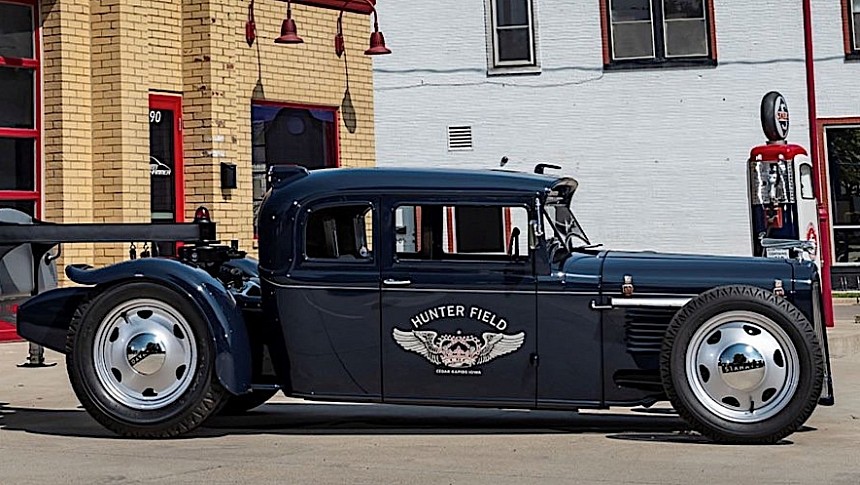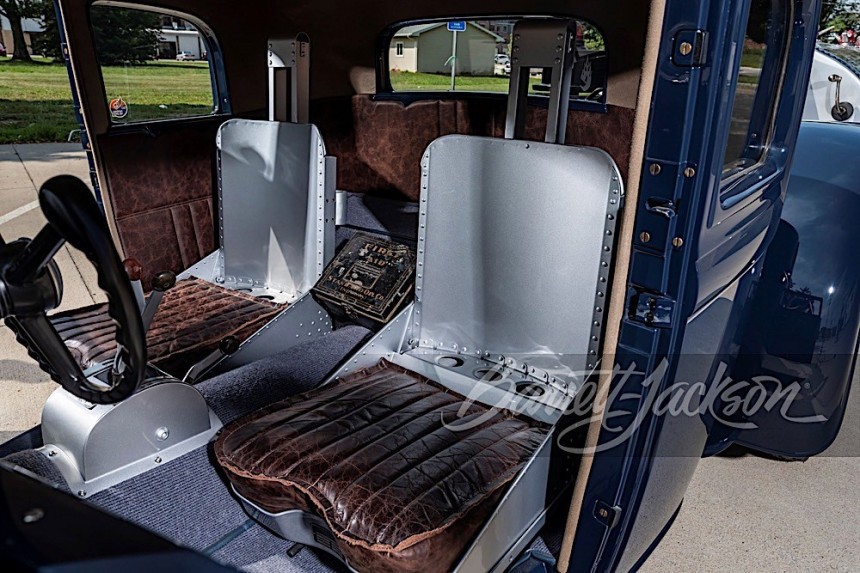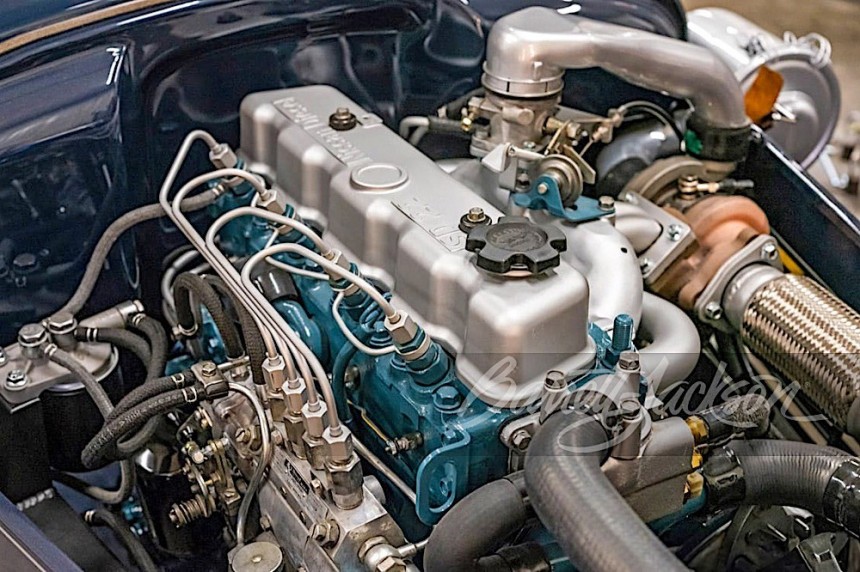The American custom car scene is unlike any other in the world. Rich and vibrant, it comes with little obstacles in the way of people having their way with vehicles. Most of the time, that works like a charm, other times, less so. You be the judge of where the 1932 Willys Low Standard fits best.
Willys was once an important name on the American carmaking scene, but that has not been the case for many, many years now. It is, however, kept alive by the few people who know what the brand was all about.
Although one needs to be a true connoisseur to be in the market for such a ride (and even more so to make one), it's more than obvious that every time one comes under the spotlight, it is bound to catch the eye of everyone who's looking. Case in point: the Low Standard.
That's the stage name for a customized 1932 Willys that's so radical it makes all other Willys-based builds we know of hide in shame. And the same goes for the model line this thing once belonged to because there's almost nothing left on it tying it to the past.
The build is the work of an Iowa-based garage that goes by the name Eddie's Rod & Custom. It was made for the 2018 SEMA show, where it also won the first place in the truck category. Wait, did I say truck?
I sure did, because that’s what this thing was turned to. Among the huge amount of changes made to its body, perhaps the most obvious is the absence of the rear doors. That, and the rear section moved significantly forward, give the ride the look of an extended cab pickup truck.
The rear end does not come with a bed, but with connecting hardware on which a Standard Oil-themed hot-rod tanker could be attached. The tank dates back to the early 1900s, and it is now used not to carry oil, but is a sort of removable trunk with storage space inside.
At the opposite end the car's elegant front grille was chopped by no less than six inches, and the headlights were dropped low to the ground, to each side of it (the lights at the rear are mounted on the roof and come from a 1937 Oldsmobile).
To make the Willys even more impressive, the shop also cut into the thing's height, chopping no less than two inches from its top and adding an opening smack down in the middle. Once that was done, all of the vehicle's wood. Structures were replaced with steel ones, a channeled floor was built, and an entirely custom frame was fitted under that.
The front of the structure of the Low Standard is supported by a modified axle and mono-leaf spring suspension setup, sourced from a Ford. The opposite end, on the other hand, rests on leaf springs and is equipped with a Ford 9-inch rear end.
The cabin that sits on top of all of this is something you'll probably not find anywhere in the world, a collection of vintage aviation elements that'll make you drool at the sight of something that may very well be the cockpit of a World War II bomber.
In fact, the seats you see there have been sourced from such an aircraft, a B-25, to be more precise. In between them there is the throttle control taken from a 1937 Bristol Blenheim bomber, which has been adapted to work as the shifter for the 5-speed manual transmission.
The car's 18-inch front wheels are steered with the help of a column that ends in a control yoke that once belonged to a Convair 440. The dashboard doesn’t have any instruments, except for an airspeed indicator. That's right, an air speed indicator, and one that works, too, thanks to a pitot tube installed on the roof.
All of the above paint the picture of a ride with many levels of badassery, and would have you believe the rest of the car's mechanical details fall in line with what we get from American custom garages, down to the large and powerful American-made engine and transmission. That's a false assumption as this build is small and weak at heart.
For some reason, the garage responsible for the project decided not to go for the large displacement V8 engines we usually get in these bodies. The choice of powerplant is bizarre, to say the least: the engine bay holds a turbo-diesel Nissan SD22 engine!
The powerplant has a displacement of 2.2 liters, and it comes in a four-cylinder configuration. We don't know how much power the unit develops in this application, but they were nothing to be proud of to begin with: at most 80 horsepower came out of it back in the day (read the 1960s to the 1980s).
The car as you see it, tanker included, is for sale during the Barrett-Jackson auction taking place in Scottsdale, Arizona, at the end of the month. It's going with no reserve, meaning there is no way to estimate how much it is going to fetch.
Update: sold for $210,100.
Although one needs to be a true connoisseur to be in the market for such a ride (and even more so to make one), it's more than obvious that every time one comes under the spotlight, it is bound to catch the eye of everyone who's looking. Case in point: the Low Standard.
That's the stage name for a customized 1932 Willys that's so radical it makes all other Willys-based builds we know of hide in shame. And the same goes for the model line this thing once belonged to because there's almost nothing left on it tying it to the past.
The build is the work of an Iowa-based garage that goes by the name Eddie's Rod & Custom. It was made for the 2018 SEMA show, where it also won the first place in the truck category. Wait, did I say truck?
I sure did, because that’s what this thing was turned to. Among the huge amount of changes made to its body, perhaps the most obvious is the absence of the rear doors. That, and the rear section moved significantly forward, give the ride the look of an extended cab pickup truck.
The rear end does not come with a bed, but with connecting hardware on which a Standard Oil-themed hot-rod tanker could be attached. The tank dates back to the early 1900s, and it is now used not to carry oil, but is a sort of removable trunk with storage space inside.
To make the Willys even more impressive, the shop also cut into the thing's height, chopping no less than two inches from its top and adding an opening smack down in the middle. Once that was done, all of the vehicle's wood. Structures were replaced with steel ones, a channeled floor was built, and an entirely custom frame was fitted under that.
The front of the structure of the Low Standard is supported by a modified axle and mono-leaf spring suspension setup, sourced from a Ford. The opposite end, on the other hand, rests on leaf springs and is equipped with a Ford 9-inch rear end.
The cabin that sits on top of all of this is something you'll probably not find anywhere in the world, a collection of vintage aviation elements that'll make you drool at the sight of something that may very well be the cockpit of a World War II bomber.
In fact, the seats you see there have been sourced from such an aircraft, a B-25, to be more precise. In between them there is the throttle control taken from a 1937 Bristol Blenheim bomber, which has been adapted to work as the shifter for the 5-speed manual transmission.
The car's 18-inch front wheels are steered with the help of a column that ends in a control yoke that once belonged to a Convair 440. The dashboard doesn’t have any instruments, except for an airspeed indicator. That's right, an air speed indicator, and one that works, too, thanks to a pitot tube installed on the roof.
For some reason, the garage responsible for the project decided not to go for the large displacement V8 engines we usually get in these bodies. The choice of powerplant is bizarre, to say the least: the engine bay holds a turbo-diesel Nissan SD22 engine!
The powerplant has a displacement of 2.2 liters, and it comes in a four-cylinder configuration. We don't know how much power the unit develops in this application, but they were nothing to be proud of to begin with: at most 80 horsepower came out of it back in the day (read the 1960s to the 1980s).
The car as you see it, tanker included, is for sale during the Barrett-Jackson auction taking place in Scottsdale, Arizona, at the end of the month. It's going with no reserve, meaning there is no way to estimate how much it is going to fetch.
Update: sold for $210,100.













